
albert Chan
What’s the Story?
In a constantly changing retail space, the ability to adapt to consumer preferences around both shopping and fulfillment is important. In addition to improving the front-end customer experience, retailers should also examine back-end operations. Traditional retailers are facing challenges in collaborating effectively with suppliers and supply chain partners in order to compete with new retail innovators. In a heightened competitive environment, disconnected systems are a hinderance to supply chain agility. Retailers are therefore in need of a simple, efficient and powerful means of business collaboration, which has led to the development of MEPs.
The Covid-19 pandemic has further accelerated the need for digital transformation and is forcing retailers to adapt new business practices, with many corporate offices closed and international (and domestic travel) is no longer an option. Digital collaboration technologies are becoming a must-have for supply chain efficiency.
MEPs unlock opportunities to optimize operations and facilitate business expansion. Retailers that have implemented this type of solution have seen increases in revenues by differentiating product lines and leveraging new sales channels, as well as margin improvements, cost reductions, improved inventory turnover, operational efficiency and streamlined supply chain operations. It is not only retailers that benefit: By using MEPs, vendors, suppliers and other participants in the retailer’s ecosystem are able to tighten strategic partnerships and streamline operations as well.
Digitalization has impacted the transformation of supply chain management over the last 25–30 years. What began as one-to-one digital communication (sharing Excel files, photos and scope-of-work documents via email), has evolved to the MEP many-to-many model of simultaneous communications, interactions and collaboration—maximizing the value of a broad digital network of participants, that, combined, accomplish more in less time than that was possible in previously siloed relationships.
In this report—which is sponsored by Bamboo Rose, a leading multi-enterprise product and supply chain platform catering to retailers, brands and wholesalers—we discuss the benefits of the MEP solution for retailers. We include analysis from a May 2020 Coresight Research survey of 118 US retailers and direct-to-consumer (DTC) brands. We asked respondents about the business issues and investments they are focusing on amidst Covid-19 and about their experience using digital platforms/MEPs.
Supply Chain Agility and Flexibility Is the Top Business Issue for Retailers
With Covid-19 continuing to drive revenue instability, retailers are paying special attention to fine-tuning their supply chains. Our survey saw almost half of retailers cite supply chain agility and flexibility as their most pressing business issue over the next 12‒24 months. Some 41% of retailers reported that finding new suppliers and leveraging current suppliers are top business issues going forward, while 39% are focused on supply chain transparency and traceability (see Figure 1).
These urgent issues that retailers are facing underscore the importance of deploying an MEP that offers a variety of functions and benefits for product and supply chain operations (which we will discuss later).
[caption id="attachment_115464" align="aligncenter" width="700"]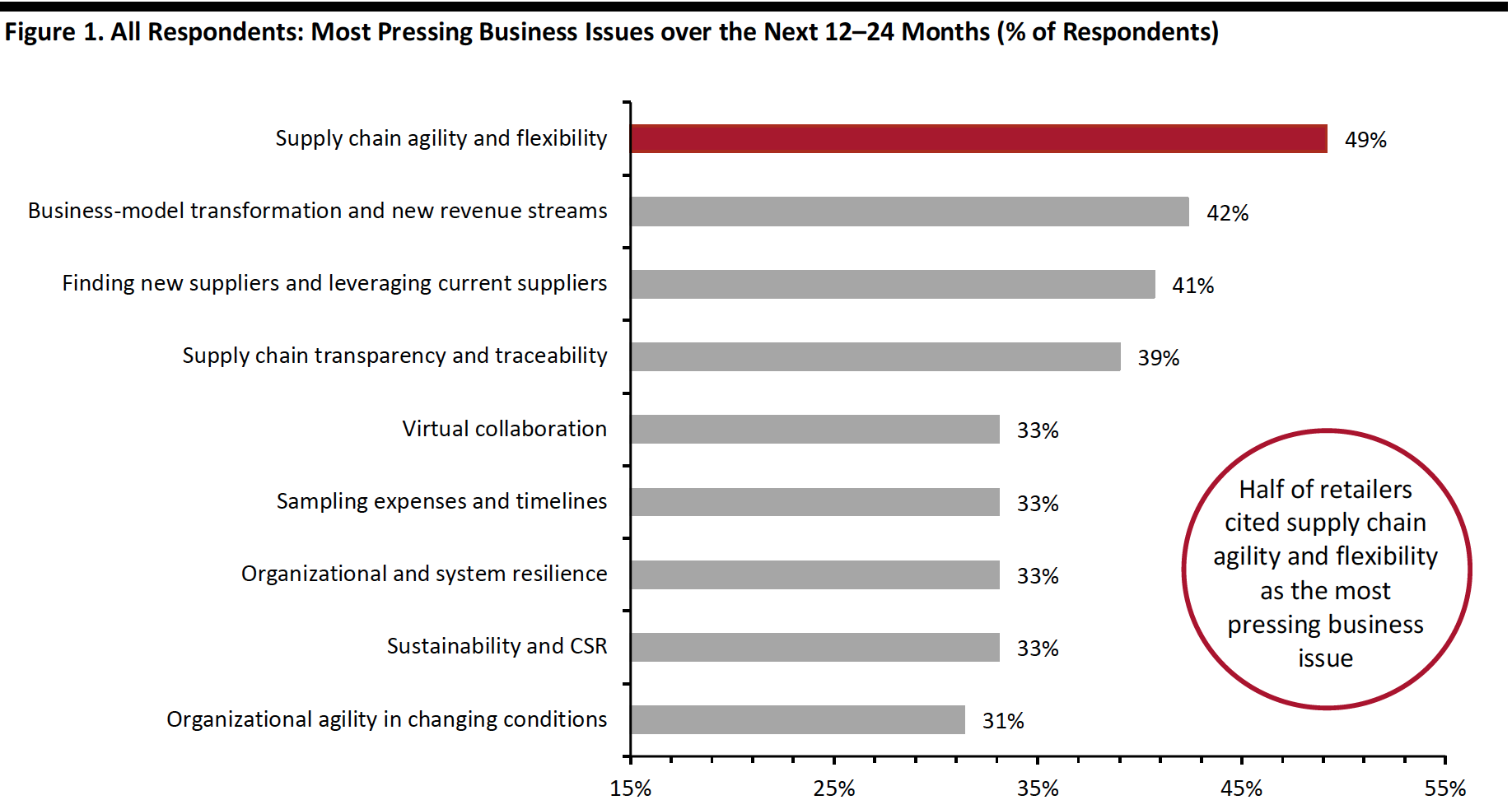 Respondents could select multiple options
Respondents could select multiple optionsBase: 118 US retailers and brands
Source: Coresight Research[/caption]
Retailers are increasingly demanding more from their merchants and supply chain leaders. Our survey asked retail executives and senior leaders to rate the importance of factors in their jobs and their corresponding level of satisfaction. The ability to see financial implications of a decision in real time was the number-one factor, with 57% of retailers citing this option as “extremely important,” followed by the ability to maintain consistent data across different platforms (56%). MEPs can support these capabilities, as real-time collaboration with vendors and digitalization of the supply chain are critical enablers to increased forecasting accuracy and improved decision-making.
[caption id="attachment_115465" align="aligncenter" width="700"]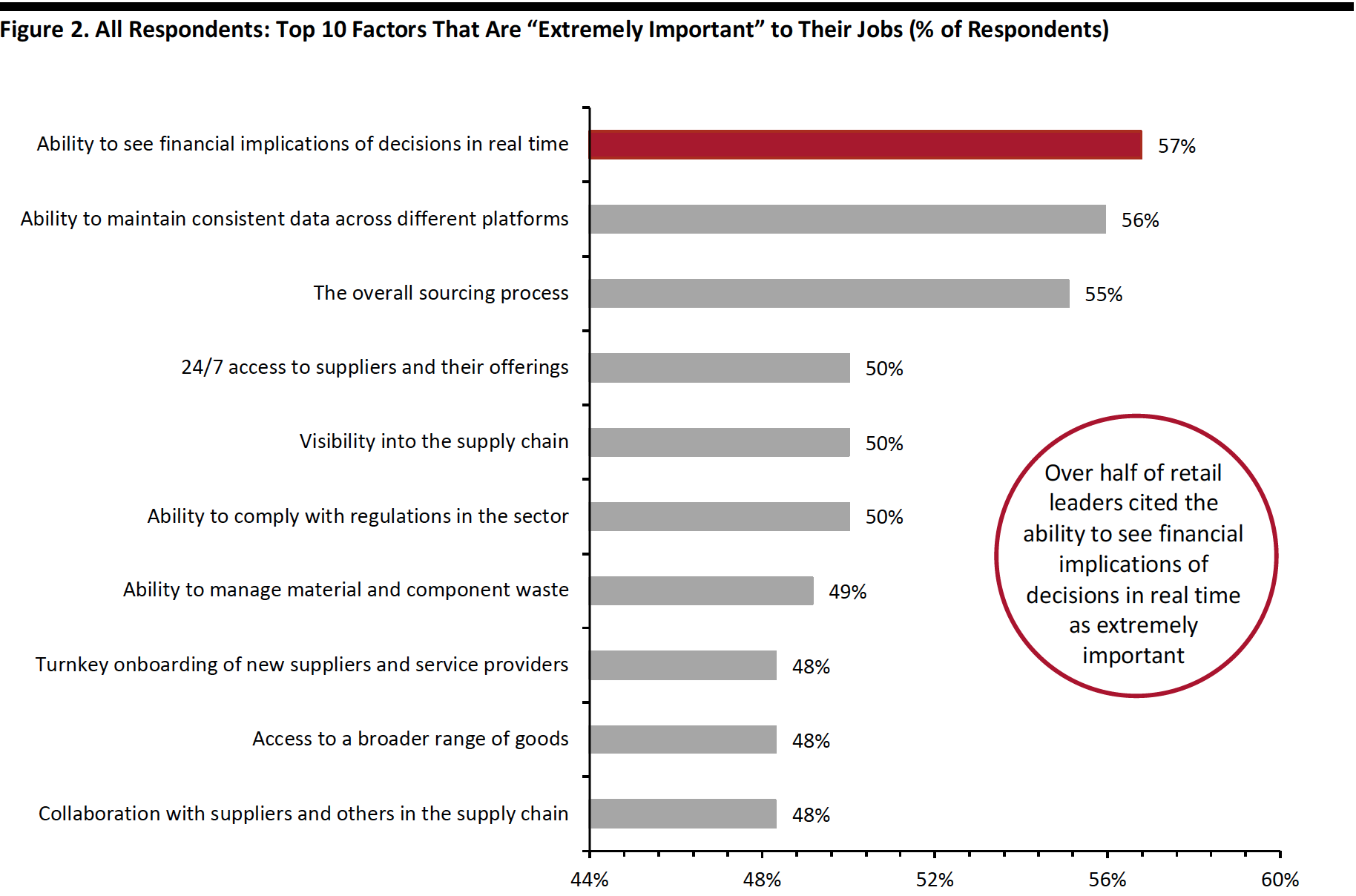 Base: 118 US retail executives and senior leaders
Base: 118 US retail executives and senior leadersSource: Coresight Research[/caption]
What Was Versus What Can Be: The Transformation of the Digital Supply Chain
The first iteration of the digitalization of the supply chain, Gen 1, took communication from an analog phone call and fax exchange (documents such as designs and order specifications) to email. At this stage, digitalization simply consisted of moving messages (through EDI, electronic data interchange) and digitizing data on a one-to-one basis. There was no interaction with content or results, but the derived business value was improved efficiency in receiving information and sending messages.
As digitalization matured to the second generation, Gen 2, the functionality of a one-to-many organizational digital platform evolved; the retailer became the hub that connects with all relevant business partners in various departments, office locations and geographies to support a comprehensive single view of an organization’s transactional data. We believe that the majority of retailers are using platforms in a Gen 1 and Gen 2 manner and not reaping the full benefits that an MEP provides.
An MEP supports the ability to communicate, collaborate, partner or transact on a many-to-many basis, which can be transformational. Gen 3 represents the latest evolution of the digitalization of the supply chain—an MEP. It leverages community and network digitalization to enable collaboration around data to happen on one platform—the data are constantly cross-validated by all partners on the platform, thus enhancing the quality of the data. The functionality of an MEP re-engineers business processes and improves decision-making across an organization and its business partners. Supported by an application programming interface (API), MEPs allow data to be shared and accessed simultaneously across all networks, resulting in improved efficiency, lower costs, and enhanced sustainability. Artificial intelligence (AI) and machine learning drive further predictive value for MEPs.
[caption id="attachment_115466" align="aligncenter" width="700"]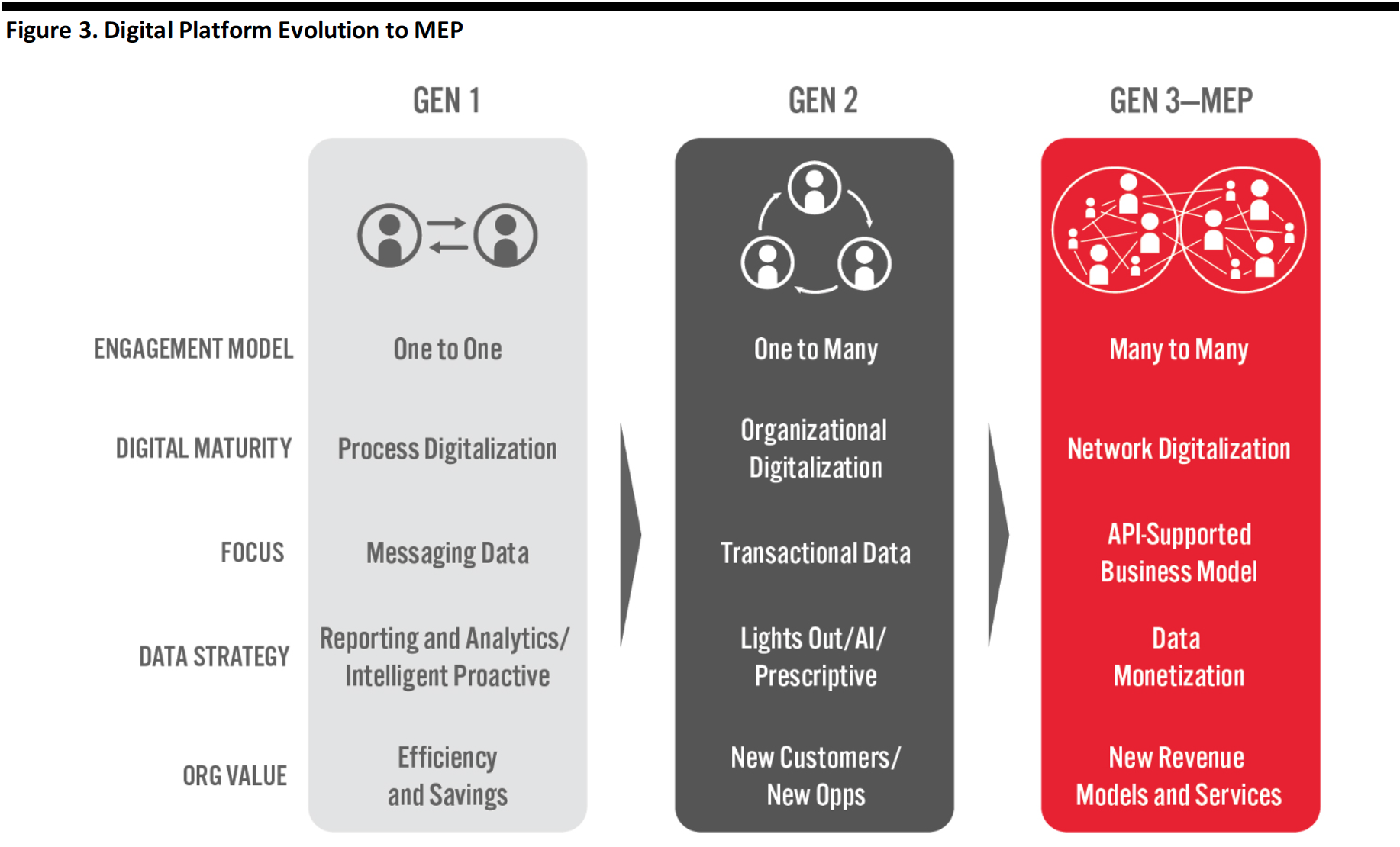 Source: Bamboo Rose/Coresight Research[/caption]
Source: Bamboo Rose/Coresight Research[/caption]
With social distancing and self-quarantine measures due to the Covid-19 crisis severely hampering traditional business practices, MEPs are paving the way for next-generation retail that is founded on technology and powered by community.
MEPs: Connecting the Product and Supply Chain Retail Community
An MEP serves as a one-stop business network that enables simultaneous communication and collaboration in the end-to-end supply chain process across all participating parties.
[caption id="attachment_115467" align="aligncenter" width="700"]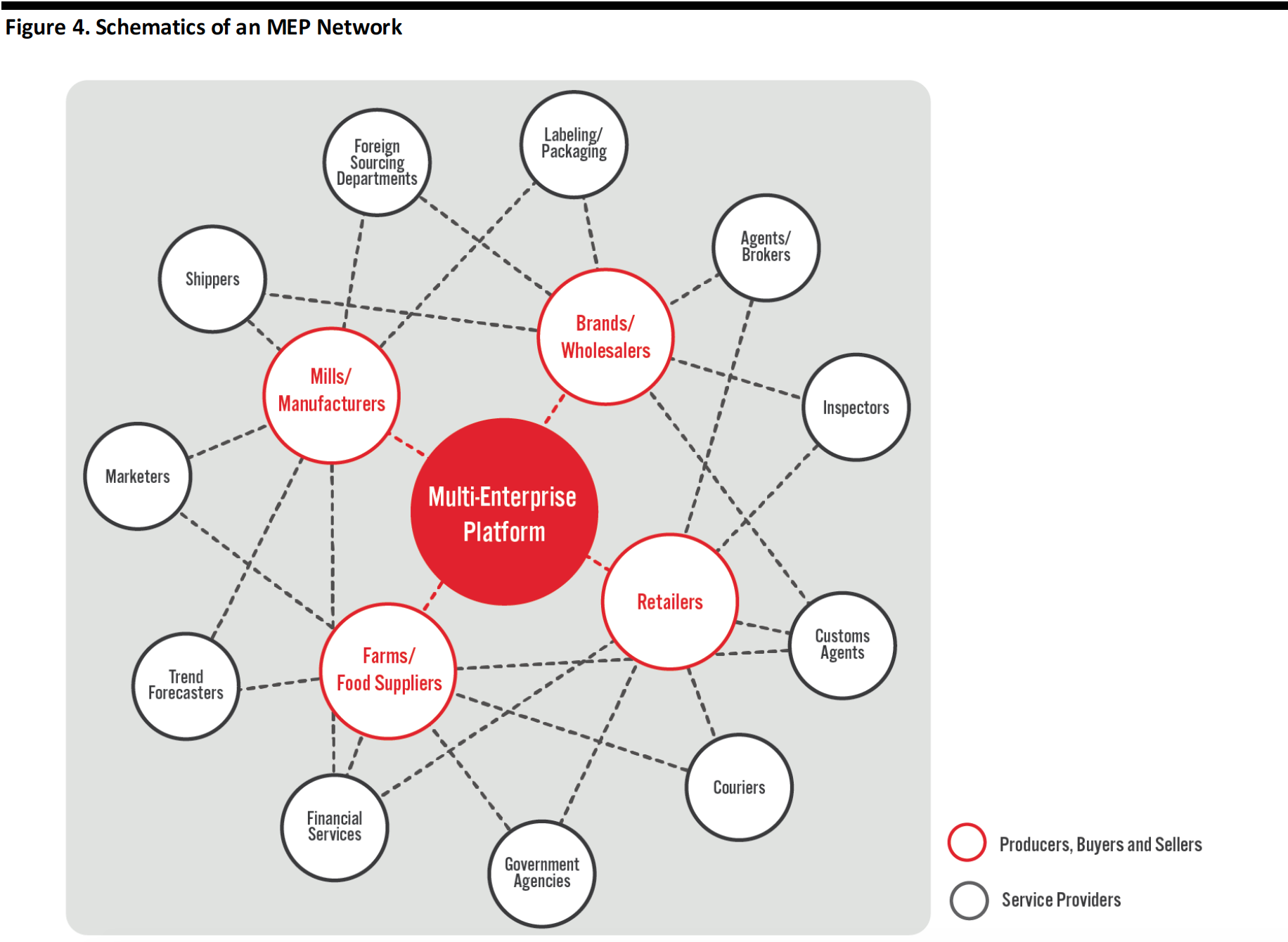 Source: Coresight Research[/caption]
Source: Coresight Research[/caption]
Below, we outline the key features of an MEP.
- Unification: Data from disparate systems and different product categories are unified on a single platform.
- Flexibility to interoperate: Participating parties can be host/hub to their network while simultaneously interoperating with other networks as a spoke—driving integrated data that builds out value.
- Connectivity: An MEP connects both internal and external parties—including retailers, international customers and franchisees, finished goods and component suppliers, freight forwarders, financial institutions, carriers, trade agents, inspection companies and other supply chain partners.
- Real-time visibility: One cloud-based hub of simultaneous data regarding product and supply chain operations.
- Optimization: Optimize operations from product creation to delivery through analysis of historic and real-time data for all community partners—driving mutual value.
- Intelligence: The platform uses data technologies such as predictive analytics, AI and ML to drive business value.
- Industry participation: A majority of industry-specific business partners are participants within the network, affording opportunities to improve the industry’s efficiency, partnerships, sustainability and transformation.
The adoption of multi-enterprise supply chain and product systems is growing within the retail industry, driven by board-level demands for collaborative networks, supply chain maturity and availability of a wide range of business applications within the platforms.
According to our survey, the number-one technology solution that retailers are thinking about investing in for their business in the next 12–24 months is supply chain management, with 60% of respondents considering doing so. This is followed by business-intelligence solutions, with almost half of retailers considering investments here.
We saw high awareness of the MEP digital solution in the retail community. Our survey showed that all respondents are aware of and are currently using one or more functions of an MEP. However, most retailers are simply leveraging Gen 1 or Gen 2 digital platforms rather than harnessing the real power of an MEP.
On average, retailers use four different technology vendors for their digital supply chain solutions. To realize the full benefits of a digitally connected network, retailers using more than one digital platform must bring them together on a single MEP. By leveraging data across the product lifecycle, retailers and their suppliers/vendors drive mutual value, everybody benefits.
Business Applications
MEPs can catalyze network collaboration around solving specific business problems, as we discuss below.
- B2B marketplace: Mimicking the B2C (business-to-consumer) marketplace, a B2B (business-to-business) marketplace simplifies the shopping process for retailers and brands by allowing them to shop and co-create products virtually, as well as collaborate with internal teams and external suppliers. The process is highly visual and social, with collaborative tools available to communicate directly with designers and suppliers. As a result, shopping and buying trips become more efficient, and retailers can lower their sampling costs by reducing the number of physical samples needed. The marketplace also gives suppliers a new sales channel to showcase and sell their products.
- Product lifecycle management: The application helps facilitate the entire product development process from design and development to testing of merchandise—thus reducing a product’s time to market. One of the key capabilities of an MEP is materials management, from samples through final products. The ability to trace and record each stage of product development has implications for sustainability compliance of apparel and food, as the compliance history of every ingredient/raw material and touchpoint would be available.
- Digital sourcing: Global sourcing becomes unified and streamlined for retailers, suppliers and their business partners. Users can have a full picture of estimated landing costs with cost-simulation software and can compare quotes easily across different geographies, channels or suppliers, resulting in increased margins. The function also validates factory capabilities, capacity and compliance before retailers place orders, to ensure regulatory adherence.
- Order management: The application combines domestic and import purchase orders. From pre-purchase to replenish, it manages factory, sample, customer and replenishment orders. Retailers can adjust and make changes to the order along the process, and the platform will automatically calculate the impact of changes. The ability to centralize all purchase orders and update orders along the way streamlines and increases visibility into the process.
- Sales order management: The application enables sharing of upcoming branded or private-label products with stores/franchisees/international retail customers, while providing transparency relative to customer assortment strategy and indication of interest in different product ideas. It also helps to align assortment with product quantities and supports transformation to wholesale operation by digitally offering goods for sale in a B2B environment. The solution supports sales offerings and operations of suppliers selling into the community, whereby suppliers sell to retailers that sell to franchisees and international partners, and for wholesalers seeking transformation to a DTC model.
- Global trade management: The application offers support on quality control, supplier compliance, customs, import and export for retailers to navigate through the complex global trade compliance and regulation. It also gives complete visibility in the entire supply chain and logistics process.
As an example, Bamboo Rose’s image-recognition capabilities leverage AI to instantly recommend a color palette, for example, by scanning photos from designers—significantly saving time during the product design process. Another valuable tool during the design cycle for retailers is 3D technology, which plugs into many tools and supports virtual design and sampling of products—thereby reducing cost and material waste, and improving sample cycle times and the overall sustainability efforts of an organization.
Bamboo Rose also utilizes ML to assist retailers in picking the right suppliers. It first analyzes preferred suppliers’ past behaviors, such as delivery accuracy and collaboration, then automatically identifies potential new suppliers that would be a good match based on the aforementioned factors as well as availability and price considerations.
Benefits of MEPs
Our survey suggests areas for potential gains from using MEPs. We asked retailers to select their top three benefits of implementing their current platform provider. Improving sales and driving global growth were both cited as a benefit by 25% of survey participants. Other top-ranked benefits were the ease of getting things done, followed by improved relationships with all partners and 24/7 access to suppliers and partners. We see opportunities for MEPs to drive the proportion seeing benefits in these areas higher, and we think the figures noted above reflect that MEP adoption is still in its early phases.
Given that most retailers are still using digital platforms in a one-to-one or one-to-many mode, they are not reaping the benefits of a many-to-many MEP, where true business-model transformation occurs, powering accelerated sales and profit growth. An MEP can drive new sales channels, new market opportunities, new customers and new partners as well as business-model diversification. We therefore expect more retailers to see the benefits summarized in Figure 6 as they continue to adapt and implement MEPs.
The real power of MEPs lies in its network effect. As a retailer onboards more of its vendors and suppliers on a unified system, collaboration and visibility across multiple business processes improve—providing a greater number of options and more-informed choices, while speeding up the time to market. As a result, all participants could see enhanced sales and profit metrics.
[caption id="attachment_115468" align="aligncenter" width="500"]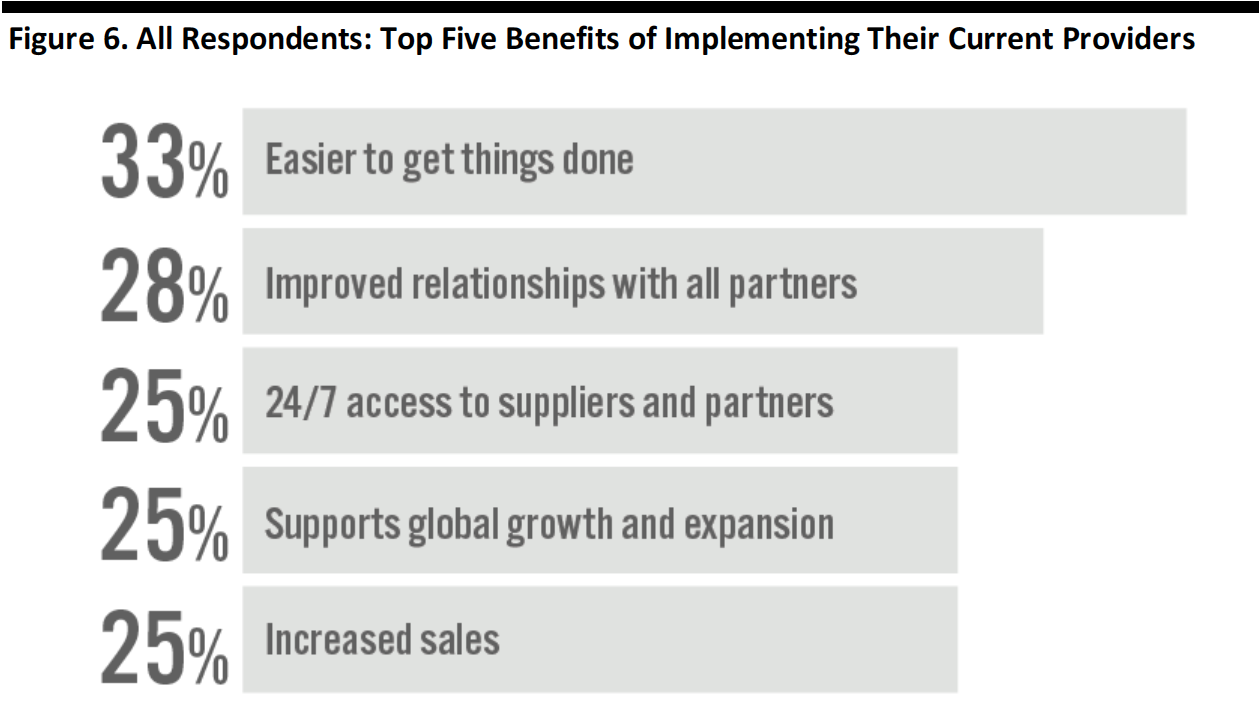 Respondents could select up to three options
Respondents could select up to three optionsBase: 118 US retailers and brands
Source: Coresight Research[/caption]
Our survey showed positive feedback from retailers that are using Bamboo Rose, with almost all users agreeing or strongly agreeing that the platform provides visibility, agility and flexibility for their supply chain. Furthermore, 83% of users agree or strongly agree that Bamboo Rose helps them collaborate with business partners, reduce material waste, improve the sourcing process and access consistent data across the business.
[caption id="attachment_115469" align="aligncenter" width="700"]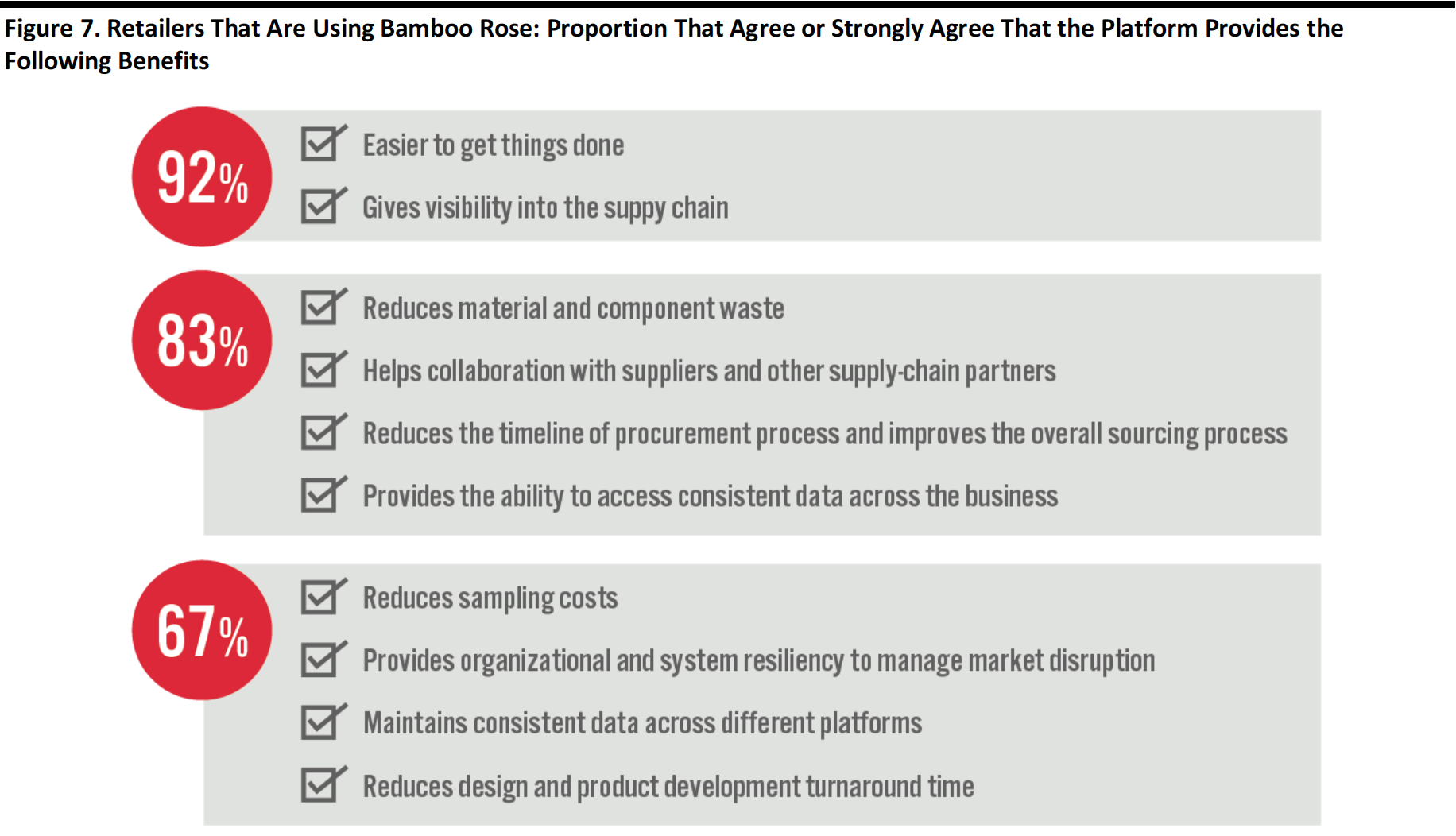 Base: US retailers and brands that are using Bamboo Rose
Base: US retailers and brands that are using Bamboo RoseSource: Coresight Research[/caption]
Below, we discuss key benefits offered by MEPs, including some shown in our survey results along with several case studies in retail.
Supply Chain Visibility
Today’s supply chains involve multiple parties outside the four walls of the organization, and without a cloud hub for collaboration, there can be a lack of visibility into product placement and transactions made across the supply chain. MEPs are able to bring all parties together on one cloud instance to create common visibility and transparency, by unifying siloed information from both internal departments and outside vendors. Through simultaneous collaboration and high-quality data, organizations are able to act more strategically and at a lower cost with all participants. Having supply chain visibility translates to shorter lead times, better management of container loads, reduced demurrage charges and improved inventory management.
Business-Model Transformation
As retailers and brands digitalize their supply chains with MEPs, they can start to monetize their value chain as a B2B service. The ability to leverage supply chain competency as a revenue generator differentiates retailers and brands in an increasingly competitive market. Additionally, the supply chain visibility provided by MEPs allows retailers to get creative in how they engage their core customers—including new sales channels and subscription-based interaction (think Rent the Runway).
Improved Trust and Relationships
Strong business relationships are an indispensable component of an efficient supply chain; challenges often arise due to lack of communication. The way in which MEPs integrate data and connect parties results in real-time and accurate information for all participating parties. This simultaneous flow of information that can be cross-verified by different entities can foster trust and better collaboration across the community. It also gives retailers the quality data they need to effectively hold their partners to predefined key performance indicators.
Enhanced Margin
MEPs use tools such as AI and ML to offer in-depth insights into supplier production. Cost-simulation capabilities can account for additional costs introduced by different development and supply chain decisions—allowing users to avoid such mistakes. Predictive analytics can leverage buying patterns over time to forecast inventory needs with better accuracy. MEPs also deliver data from multiple sources, such as point-of-sale systems, to retailers in real time. As a result, retailers can adjust quickly to customer demand and make order changes or reduce inventory imbalances to improve margin.
Reduced Risk
Improved supplier collaboration and visibility allows retailers and wholesalers to manage the regulatory and quality compliance status of their partners at a more granular level. MEPs can be configured to generate automated alerts or shut down buying if a supplier has fallen out of compliance against environmental, ethical, or consumer safety related regulatory requirements.
Faster Speed to Market
MEPs can streamline the sourcing process by providing virtual collaboration, especially during times when geopolitical disruption occurs. Shopping trips are enabled through virtual showrooms, which make it easier for retailers to browse and discover a massive number of products and compare assortments across different suppliers. At the same time, it reduces sampling costs and improves buying trip efficiency to pick more relevant products. Product cycle time can be reduced by 20–50%, according to Bamboo Rose.
New Sales Opportunities
An MEP provides opportunities for new sales channels, transformation of a wholesale model to DTC, and a more robust private-label strategy.
Case Studies
North American DIY Retailer
A market-leading DIY retailer with an annual revenue of more than $100 billion wanted to introduce innovations to drive its product assortment strategy and collaborate with suppliers. The company’s overseas buying trips were mired with pre- and post-trip administrative work, and the sampling process was costly and slow.
Using Bamboo Rose’s SaaS (software-as-a-service) B2B Marketplace, the retailer was able to bring a virtual component to its buying trips and began to collaborate with its overseas suppliers within hours of implementation. Today, the firm has reduced sampling costs by 85% and accelerated its buying cycle by six weeks. The retailer’s suppliers also save time, warehouse space and sampling costs. Most importantly, the retailer has fostered continued revenue growth in a competitive retail space—such as by driving customers to their stores in the fourth quarter through an improved seasonal product assortment.
Shoprite
Africa’s largest grocery retailer, Shoprite, was facing challenges in effectively managing and communicating with more than 3,000 suppliers in 80 countries. Previously, the company manually input and tracked information in multiple systems, resulting in a lack of overall supply chain visibility and an inability to accurately project imports and exports.
Using Bamboo Rose, Shoprite monitors all imports under a single platform, eliminating manual record-keeping while collaborating in real time with suppliers. The company has seen an 18% reduction in purchase order cycle times, a 50% reduction in the number of changes to purchase orders, and millions of dollars saved through avoided demurrage charges.
[caption id="attachment_115470" align="aligncenter" width="500"]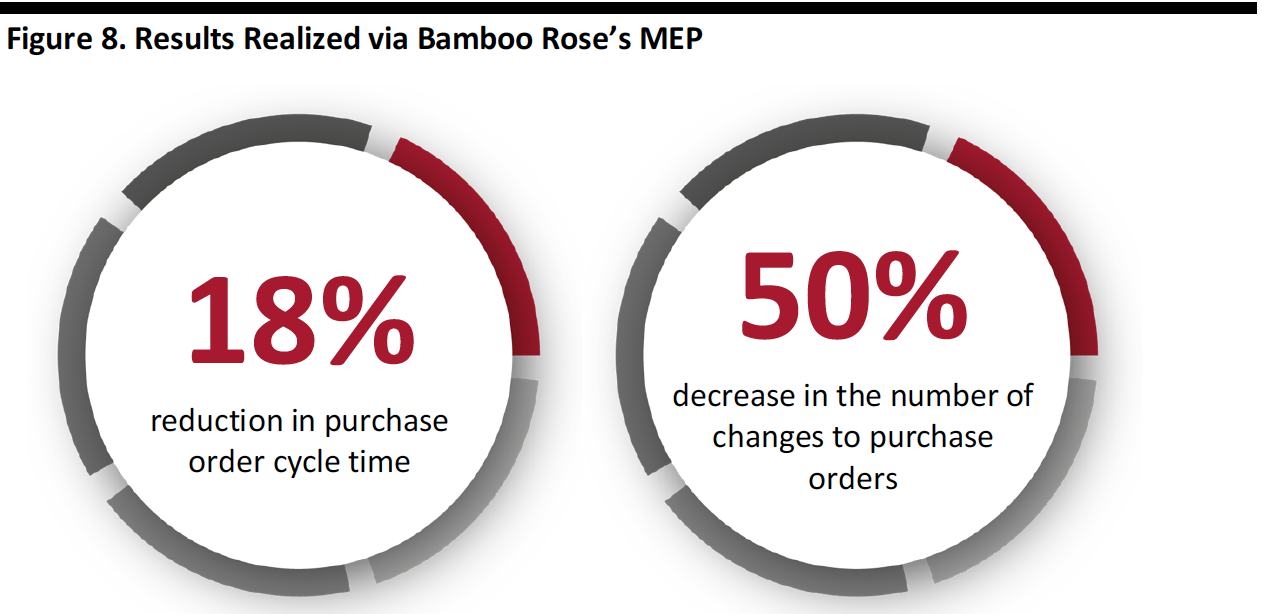 Source: Bamboo Rose/Coresight Research[/caption]
Source: Bamboo Rose/Coresight Research[/caption]
Floor & Decor
Flooring specialty retailer Floor & Decor has been expanding its store fleet and looking for equipped back-end technology to make its supply chain more efficient under complex sourcing and supplier relationships.
With Bamboo Rose’s Global Trade Management application, Floor & Decor was able to migrate all of its suppliers to the system for easier collaboration, tighter compliance management, reduced EDI transaction fees and holistic supply chain visibility. Floor & Decor was therefore able to reduce its $1 billion in safety stock by 5%– saving the company $50 million.
American Eagle Outfitters
As its business scaled up, specialty apparel retailer American Eagle Outfitters was facing challenges in efficiently managing its complex supply chain, as well as a misalignment between production scheduling and promotional events. The retailer turned to Bamboo Rose to streamline its global sourcing process with one integrated system for product lifecycle, order and global trade management. It can now automatically alert suppliers to start production and pre-plan container loads and optimal routing across different countries to improve time to market.
Through the deployment of the Bamboo Rose solution, American Eagle Outfitters was able to reduce the cost of processing invoices by 95% and take three weeks out of the design cycle, which equates to $6 million in annual savings. The ability to collaborate with more than 500 vendors in 29 countries on a single system also means that the retailer has visibility into factory readiness of product eight days sooner. Since partnering with Bamboo Rose in 2001, American Eagle Outfitters has scaled up from a $547 million retailer to a $4 billion market innovator.
[caption id="attachment_115471" align="aligncenter" width="500"]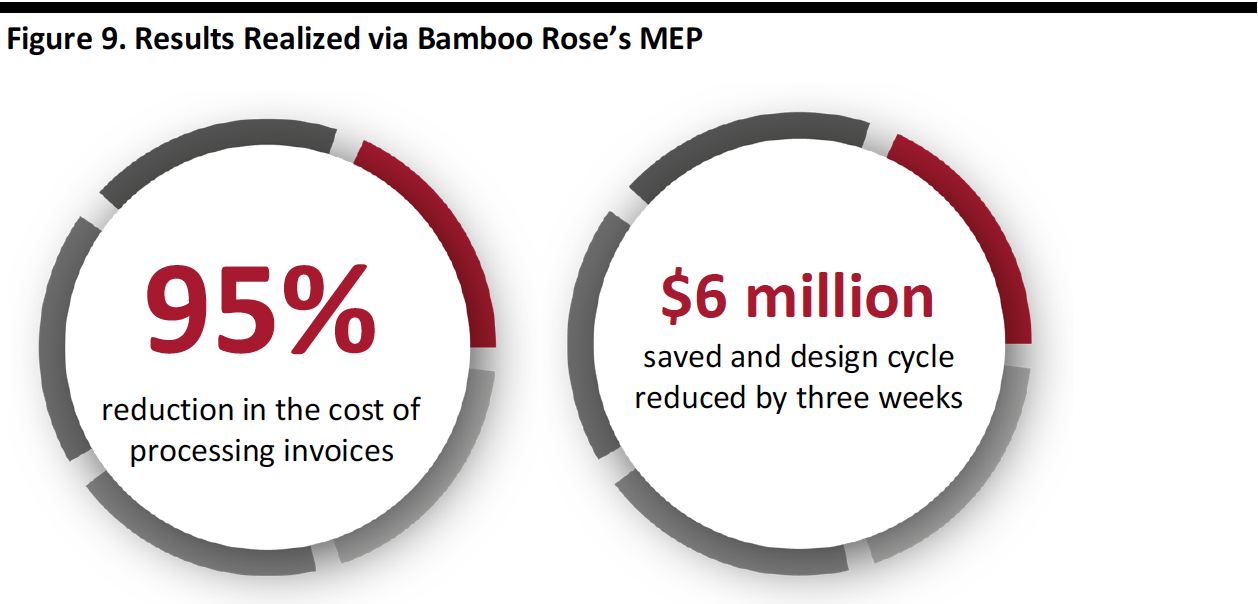 Source: Bamboo Rose/Coresight Research[/caption]
Source: Bamboo Rose/Coresight Research[/caption]
Leading US Department Store Chain
A leading US department store chain—with annual revenues of around $20 billion and more than 1,000 locations across the country—had been dealing with streamlining its product design and development processes across its 30 exclusive brands, as each brand had been managed independently in disparate systems.
A unified platform provided by Bamboo Rose has helped the company to standardize operations, manage data efficiently for all brands, connect designers and suppliers virtually and source products digitally. This leading department store chain was able to increase productivity in product development by 40% and in the sampling process by 60%. In addition, the platform has played an important role during the Covid-19 crisis, enabling employees to continue their day-to-day work in the supply chain and communicate with suppliers.
[caption id="attachment_115473" align="aligncenter" width="500"]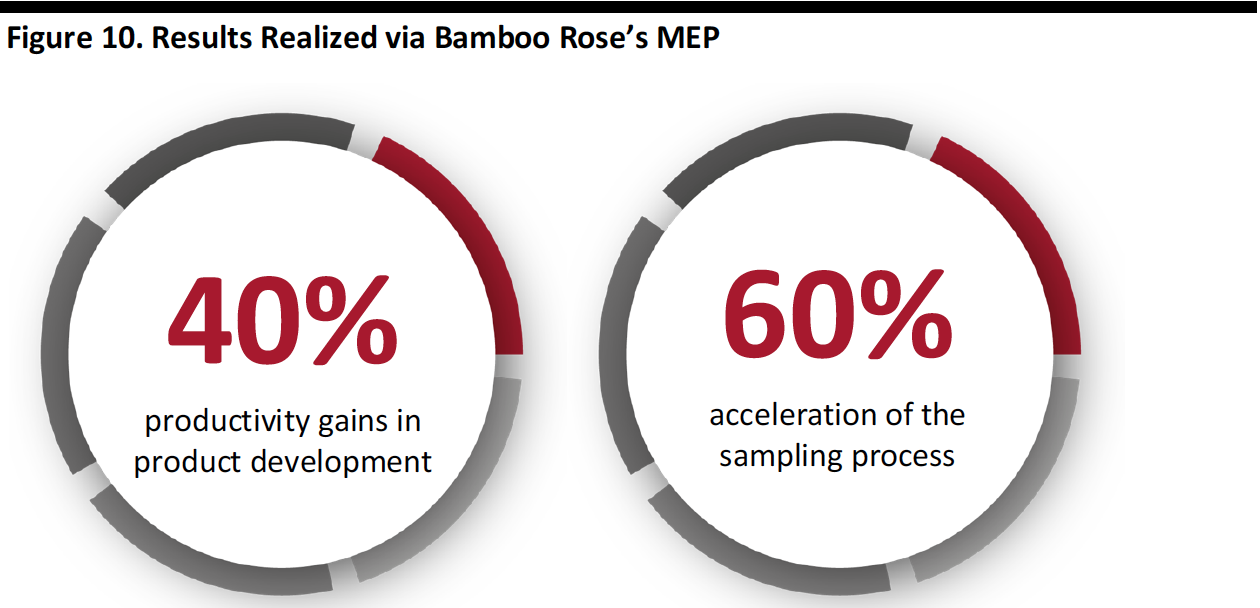 Source: Bamboo Rose/Coresight Research[/caption]
Source: Bamboo Rose/Coresight Research[/caption]
Leading North American Grocer
A North American grocer with $35 billion in annual revenue and over 15,000 suppliers was struggling with product delays—caused by user error in the product development process—siloed teams and managing product audits and certifications across product categories.
With Bamboo Rose’s MEP, the grocer was able to better collaborate with suppliers on private-brand product-line extensions and new product innovation—aligning its brand more closely with consumers and driving profits. The company also streamlined product quality and compliance through digital certification tracking, which enables factory line-level traceability. At the same time, suppliers can gain more visibility into brand standards and product specifications, and provide packaging and labeling that align with regulatory requirements, to reduce risk.
What We Think
To support multi-channel fulfillment and other customer-facing initiatives, they must invest in the digitalization of back-end operations, leveraging systems such as MEPs to provide the foundation for differentiating front-end experiences.
This concept has clearly started to resonate, as supply chain agility and flexibility were reported to be the most pressing business issue for retailers, according to our survey. Additionally, the number-one technology/solution that retailers are considering making investments into in the next 12–24 months is supply chain management, cited by 60% of our survey respondents.
We saw high awareness and adoption of MEPs in the retail community. Our survey showed that all respondents (118 retailers and brands) are aware of and currently using one or more of this type of solution. While retailers are using multiple digital network platforms to manage their businesses, few have really harnessed the power of the Gen 3 MEP.
The real power of MEPs lies in its network effect. As a retailer onboards more of its vendors and suppliers on a unified platform, communication and visibility across multiple business processes improve—providing a greater number of options and more-informed choices, while speeding up products’ time to market and enhancing sales and profitability.
As a result of the acceleration of the digitalization of retail and the supply chain caused by the pandemic and recession, we believe that the retail industry will advance dramatically over the next three to five years, with the potential to be in 2023 where it otherwise would have been in 2030. To sit out technology-centric innovation is not a viable strategy for retailers.
An MEP network effect supports the evolution of the retail industry and will result in an entirely new way in which individuals and organizations communicate and transact, dramatically increasing productivity and helping businesses to achieve their goals.
Upgrade Supply Chain Solutions with Bamboo Rose
Named a “Niche Player” in Gartner’s Magic Quadrant for Multi-Enterprise Supply Chain Business Networks, Bamboo Rose is the retail industry’s leading multi-enterprise product and supply chain platform, connecting the entire retail community and helping companies bring great products to market faster, more efficiently and at higher margins.
The company’s platform features a suite of patented supply chain business applications, including Bamboo Rose Marketplace, Product Lifecycle Management, Sourcing, Purchase Order Management, Global Trade Management and Financing, each of which is supported by intelligent engines for optimization, costing and scheduling.
Bamboo Rose serves over 250,000 user members across 85 major retailers, 500 brands and 35,000 suppliers and service providers.
Find more information at bamboorose.com